Costa Rica, my first ever international destination, captivated me from the moment I stepped off the plane. For over a decade, I’ve returned to this incredible country, drawn back by its stunning landscapes and the warmth of its people. It’s a place that truly stole my heart – so much so that I ended up marrying a Costa Rican!
[toc]
Having explored Costa Rica extensively – from my study abroad experience and internship with a field studies program to countless return trips – I’ve uncovered its hidden gems and must-see spots. I’m excited to share my knowledge and passion in this ultimate Costa Rica Travel Guide, helping you plan your own unforgettable adventure. Get ready to discover everything you need to know about traveling to Costa Rica!
 A woman wearing a red two-piece swim suit in posing on a boulder in front of a tall two-tiered waterfall
A woman wearing a red two-piece swim suit in posing on a boulder in front of a tall two-tiered waterfall
Planning Your Trip to Costa Rica: Essential Information
Costa Rica, a jewel in Central America, sits between Nicaragua and Panama. This diverse nation boasts coastlines on both the Pacific Ocean and the Caribbean Sea, offering a unique blend of experiences.
Language in Costa Rica: Spanish and More
Spanish is the official language of Costa Rica. You’ll find a unique local flavor in their Spanish, known as Costa Rican slang. However, English is widely spoken, especially amongst younger generations and in tourist areas. On the Caribbean coast, you’ll hear a fascinating English-Creole dialect, reflecting the region’s rich cultural heritage.
Costa Rica Visa Requirements for Tourists
Good news for travelers from the United States! You likely won’t need an advanced visa for tourism. Costa Rica recently updated its visa policy, now granting visitors from the US up to 180 days upon arrival. Ensure your passport is valid for at least six months beyond your intended stay. While Costa Rican immigration might allow entry with a passport valid for the duration of your trip, many US airlines enforce a stricter six-month validity rule.
For those dreaming of working remotely from paradise, Costa Rica offers digital nomad visas valid for up to two years!
Currency in Costa Rica: Colones and USD
The Costa Rican currency is the Colon (CRC). Exchange rates fluctuate, but generally hover around 500 CRC to 1 US Dollar. It’s worth noting that Costa Rica is considered the most expensive country in Central America. While you can find budget-friendly options, prices in tourist areas can often be similar to those in the United States.
Best Time to Visit Costa Rica: Weather and Seasons
Costa Rica enjoys warm weather throughout the year. San Jose, nestled in a valley, experiences milder temperatures compared to the coasts. The country has distinct wet and dry seasons. The rainy season extends from May to November, with December acting as a transitional month. The dry season, from January to April, is characterized by sunny days and minimal rainfall, though temperatures rise as the season progresses.
The Caribbean coast has its own microclimate, experiencing more rain than the rest of the country. It has two shorter dry seasons, from March to April and September to October.
Costa Rica’s weather patterns are also influenced by El Niño/La Niña. El Niño years tend to be drier, while La Niña years bring more rainfall.
Exploring Costa Rica by Province: Regions to Discover
Costa Rica is divided into seven provinces, each offering unique landscapes and experiences:
- Guanacaste: Famous for its Pacific coastline, stunning beaches, and surfing hotspots.
- Puntarenas: The largest province, offering national parks and diverse wildlife along the Pacific Coast.
- Alajuela: Home to volcanoes and lush coffee plantations inland.
- Heredia: Known as “Little Switzerland,” with green hills and charming villages.
- San Jose: The bustling capital city, rich in culture.
- Cartago: Showcasing colonial architecture and historical ruins.
- Limón: On the Caribbean coast, influenced by Afro-Caribbean culture, with vibrant music and rainforests.
🤩 Enhance your trip and learn Spanish in Costa Rica!
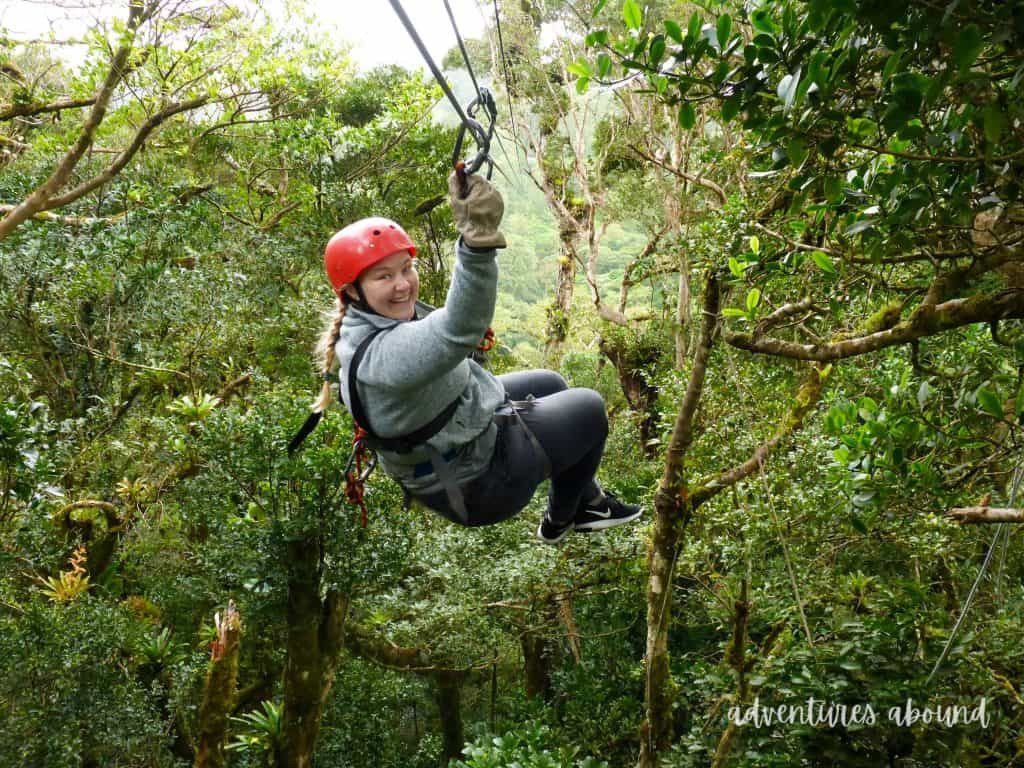 A girl wearing a red helmet and ziplining during a trip to Costa Rica.
A girl wearing a red helmet and ziplining during a trip to Costa Rica.
Discover the Wonders of Costa Rica: What to See and Do
Costa Rica’s allure lies in its diverse offerings. From world-class coffee and stunning nature to thrilling adventures and unique wildlife, there’s something for every traveler.
Coffee Culture in Costa Rica: From Bean to Cup
Coffee is deeply woven into the fabric of Costa Rican culture. As you explore, the rich aroma of roasting coffee beans will become a familiar and comforting scent. It was in Costa Rica that I truly learned to appreciate quality coffee, enjoying it black without sugar or cream.
The high altitudes and volcanic soils of Costa Rica create ideal growing conditions, producing beans with a distinctive and globally sought-after flavor profile. This has solidified Costa Rica’s reputation as a premier coffee exporter. Whether you’re savoring a perfectly brewed cup in a trendy San Jose café or visiting a family-run coffee farm in the Alajuela hills, you’ll understand why Costa Rican coffee is a source of national pride and international acclaim.
Nature and Wildlife: Costa Rica’s Biodiversity Hotspot
Despite its small size, covering only 20,000 square miles, Costa Rica is a natural wonderland. It’s home to an incredible array of landscapes: breathtaking beaches, majestic waterfalls, lush rainforests, ethereal cloud forests, winding rivers, soothing hot springs, and impressive volcanoes. You might even witness the magical glow of bioluminescence on certain beaches!
Adventure Activities in Costa Rica: Thrills and Spills
For adrenaline seekers, Costa Rica is an adventure playground. From ziplining through rainforest canopies and challenging hikes to exhilarating white-water rafting, world-class surfing, skydiving, and waterfall rappelling, the possibilities for adventure are endless.
☕ Embark on a specialty coffee and chocolate farm tour in Costa Rica! 🍫
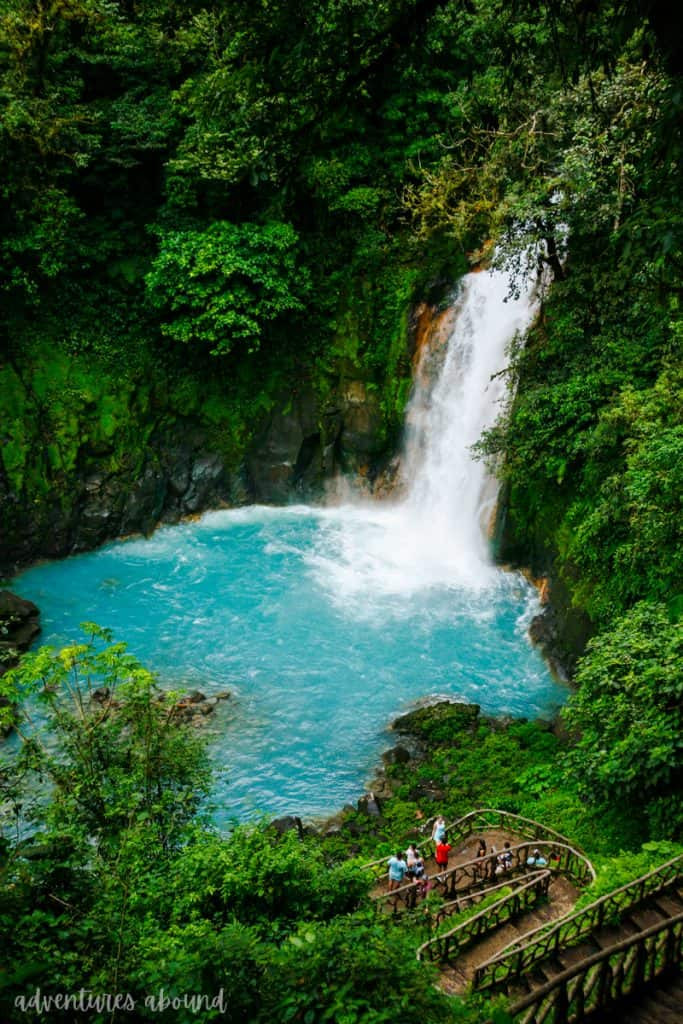 A waterfall pours into a bright blue river surrounded by lush green jungle in Costa Rica.
A waterfall pours into a bright blue river surrounded by lush green jungle in Costa Rica.
Wildlife Encounters: Animal Watching in Costa Rica
Costa Rica is a biodiversity hotspot, housing a staggering 4% of the world’s biodiversity within just 0.03% of the Earth’s land surface. This natural paradise teems with life, from four species of monkeys and migrating whales to vibrant tropical birds and nesting sea turtles.
Perhaps no animal embodies the laid-back pura vida lifestyle better than the sloth, a national icon. Costa Rica is home to both two-toed and three-toed sloths.
A trip to Costa Rica often feels like an impromptu safari, offering enchanting encounters with diverse wildlife. Whether you’re a passionate birdwatcher, a marine life enthusiast, or simply an animal lover, Costa Rica’s fauna promises an unforgettable experience.
Pro Tip: Keep an eye out for clusters of tourist vehicles or groups of people stopped along trails. They often indicate wildlife sightings – a sloth, toucan, or another fascinating creature of Costa Rican wildlife might be nearby!
 An ornately-decorated colorful hand-painted oxcart.
An ornately-decorated colorful hand-painted oxcart.
Getting Around Costa Rica: Transportation Options
Exploring Costa Rica on a budget is entirely possible with some smart planning. If you’re willing to embrace local experiences, public transportation is a fantastic and affordable option.
Costa Rica’s extensive bus system reaches even remote corners of the country. Traveling by bus allows you to immerse yourself in local life, interacting with Ticos (Costa Ricans) and fellow travelers. In fact, bus rides were my Spanish practice sessions during my study abroad – conversations with locals and even the bus drivers were invaluable!
For time-sensitive travel, consider small domestic flights to destinations like Tortuguero and Corcovado National Park on the Osa Peninsula. While pricier than buses, they are significantly more economical than private charters.
Boats offer quicker and more convenient access to destinations like Tortuguero and the Nicoya Peninsula compared to buses. While slightly more expensive than public transport, they remain budget-friendly and save considerable travel time.
Private shuttles, or private transfers, are readily available to popular tourist areas throughout Costa Rica. These are ideal for larger groups, travelers with luggage, or those planning to stay in a few key locations.
Hiring a private driver is another excellent option, especially for group travel, as you can split the cost. Local drivers often provide valuable insights and recommendations along the way.
Taxis are common in Costa Rican cities. In San Jose, official taxis are red with a yellow triangle. Always ensure the driver uses the meter (“la maria”) or agree on a fare beforehand.
Uber, while technically unregulated in Costa Rica, has been operating for years and is often a more affordable alternative to taxis. Be mindful of local regulations.
For ultimate freedom, consider renting a car. This allows you to explore Costa Rica at your own pace. While this is my preferred way to travel, I always let my Costa Rican husband handle the driving – Costa Rican traffic can be a bit more adventurous than I’m used to! Remember that mandatory insurance can increase the overall rental cost.
No matter your chosen mode of transport, navigating Costa Rica’s stunning landscapes is an adventure in itself!
🚗 Find the best deals on car rentals in Costa Rica 🚗
 Two people sitting in a hot spring pool in La Fortuna, surrounded by lush nature.
Two people sitting in a hot spring pool in La Fortuna, surrounded by lush nature.
Top Attractions and Things to Do in Costa Rica
Costa Rica is brimming with incredible experiences. Here are some must-see destinations and activities to include in your Costa Rica travel itinerary:
San Jose: Unveiling the Capital City
San Jose, home to one of Costa Rica’s two international airports, is often the first stop for visitors. While many travelers quickly head to natural destinations, San Jose has much to offer. Explore its museums, savor international cuisine, and relax in its beautiful parks.
Costa Rica Beaches: Pacific and Caribbean Paradise
Costa Rica is world-renowned for its beaches. Popular Pacific beaches include Papagayo, Tamarindo, Playa Conchal, and Playas del Coco in Guanacaste; Montezuma, Sámara, Nosara, and Manzanillo on the Nicoya Peninsula; Jacó, Playa Hermosa, Punta Leona, Manuel Antonio, Dominical, and Uvita further south. On the Caribbean coast, our favorites are the beaches around Puerto Viejo – Playa Negra, Playa Cocles, Punta Uvita, Playa Chiquita, and Playa Manzanillo).
Volcanoes of Costa Rica: Majestic Giants
Costa Rica’s volcanoes are a sight to behold. Consider visiting Irazú, Poás, Arenal, Rincón de la Vieja, and Tenorio. Each volcano offers a unique experience and is worth a visit. Irazú, Poás, and Arenal are easily accessible for day trips from San Jose.
National Parks: Preserving Natural Beauty
Exploring Costa Rica’s National Parks is like stepping into a biodiversity paradise. Braulio Carillo National Park, easily reached from San Jose, is perfect for hiking through rainforests and discovering waterfalls and wildlife. Carara National Park is a birdwatcher’s haven, bridging Amazonian and Mesoamerican ecosystems.
On the Caribbean coast, Cahuita National Park combines coral reefs, beaches, and rainforests, ideal for snorkeling and wildlife spotting. Tortuguero National Park is a maze of mangrove forests and lagoons, famous for sea turtle nesting.
Manuel Antonio National Park, despite being small, is a gem with beautiful beaches, trails, and monkey and sloth sightings. Challenge yourself at Chirripó National Park by hiking to Costa Rica’s highest peak for stunning views. Palo Verde National Park in Guanacaste is a haven for water birds.
Finally, Corcovado National Park, known as “the most biologically intense place on earth,” is a must for adventurous travelers seeking rare wildlife like jaguars and tapirs. Each park offers a unique window into Costa Rica’s diverse ecosystems.
🦥 Book a guided nature hike in Manuel Antonio National Park 🦥
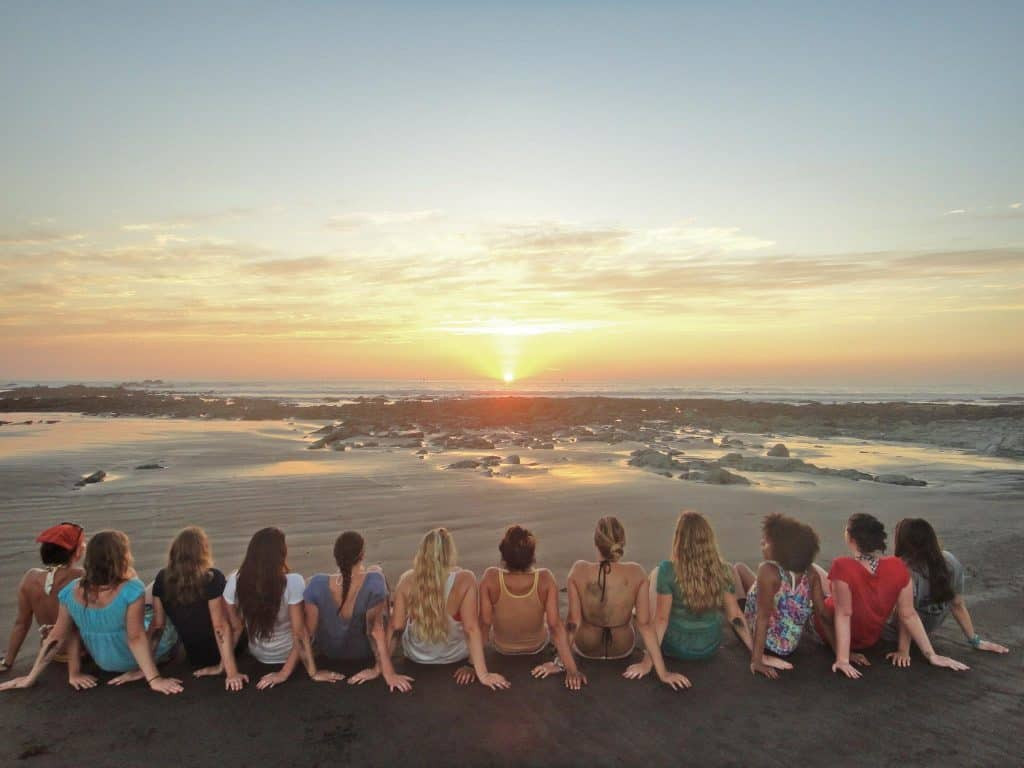 Twelve young women sitting next to each other on a beach looking toward the ocean at sunset.
Twelve young women sitting next to each other on a beach looking toward the ocean at sunset.
Must-Visit Destinations: Monteverde, La Fortuna, and More
- Monteverde: Explore the mystical cloud forest, teeming with biodiversity and offering some of the best ziplining in Costa Rica. It’s one of my personal favorite places!
- La Fortuna: Located near the Arenal Volcano, La Fortuna is an adventure hub with hiking, rafting, and horseback riding. Don’t miss La Fortuna Waterfall, La Paz Gardens, and numerous hot springs.
- Rio Celeste: Located in Tenorio Volcano National Park, Rio Celeste is famed for its vibrant blue river flowing through the jungle. The unique turquoise color makes it a must-see.
- Osa Peninsula: This remote and biodiverse peninsula is home to Corcovado National Park, Drake Bay, and Puerto Jimenez. Ideal for eco-tourism and wildlife lovers.
 A couple on the foreground sitting on the grass in a city park, with more people walking on the sidewalk and street.
A couple on the foreground sitting on the grass in a city park, with more people walking on the sidewalk and street.
Day Trips from San Jose: Exploring Nearby Gems
- Cartago: The former capital, a short trip from San Jose, known for the Basilica of Our Lady of the Angels and Santiago Apostol Church ruins. Gateway to Irazu Volcano National Park.
- Alajuela: Northwest of San Jose, birthplace of national hero Juan Santamaria. Visit his museum and Zoo Ave, a wildlife rescue center.
- Heredia: “City of Flowers,” explore colonial architecture, including the Church of the Immaculate Conception and Café Britt coffee farm.
- Sarchí: Famous for colorful oxcarts. Shop for handicrafts and see the Guinness World Record holding largest hand-painted oxcart.
- Zarcero: Mountain town with a whimsical topiary garden and striking pink and blue church.
- Orosi: Tranquil valley with stunning views, the oldest church in Costa Rica still in use, Tapanti National Park, and hot springs.
🌋 Book a tour to a coffee farm, volcano, and waterfall near San Jose! 🌿
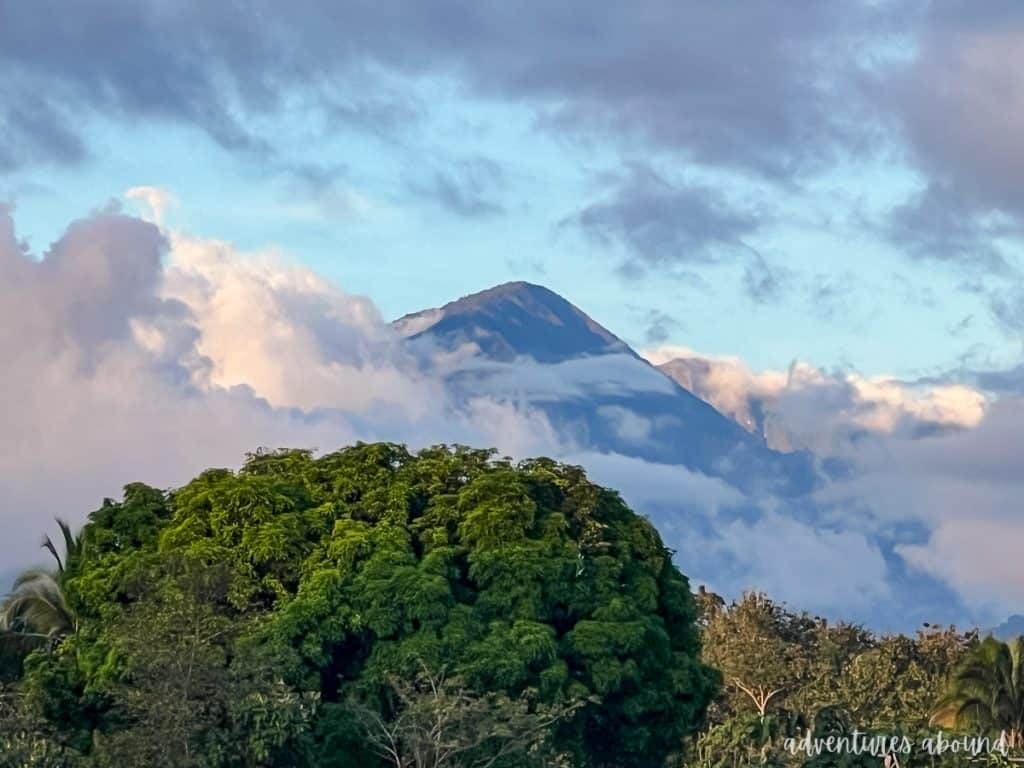 A mountain top coming out of the clouds in front of a tropical woody area.
A mountain top coming out of the clouds in front of a tropical woody area.
Costa Rica Travel Tips: Safety and Practicalities
Staying Safe in Costa Rica: Tips for Travelers
Costa Rica is generally a safe country for travelers, but petty theft can occur, especially in urban areas.
In cities like San Jose, be mindful of pick-pocketing. Keep valuables secure and out of sight. When using your phone for photos or navigation, keep it secure in your front pocket or a closed bag when not in use.
Dress modestly to avoid drawing attention. Wear closed-toe shoes and long pants when possible in cities. Carry bags in front of you and keep a hand on them at all times.
Refer to our comprehensive guide on safety in Costa Rica for detailed advice.
Avoid walking alone at night, even in groups, due to the risk of petty theft.
While less common, incidents of tourists being threatened for valuables like cell phones are increasing. Be vigilant and aware of your surroundings.
The emergency number in Costa Rica is 911.
Travel insurance is highly recommended to protect yourself against unforeseen events, including illness and accidents.
🏥 Get a quote for travel insurance for your Costa Rica trip 🏥
 A small set of ferny leaves sitting on top of a large banana leaf.
A small set of ferny leaves sitting on top of a large banana leaf.
Costa Rica Map: Plan Your Route
[Map of Costa Rica – Consider embedding a map here if possible, or linking to an external map]
FAQs for Your Costa Rica Trip
What is the best time of year to visit Costa Rica?
The dry season, from December to April, is the best time to visit Costa Rica for optimal weather. However, avoid late December and late March/early April due to local travel during Christmas and Holy Week, which can lead to larger crowds.
Is Costa Rica safe for tourists?
Yes, Costa Rica is generally safe for tourists. Exercise caution against petty theft, especially in crowded areas and cities. Secure your belongings, avoid walking alone at night, and be aware of your surroundings.
How expensive is a trip to Costa Rica?
Costa Rica is considered a mid-range to expensive travel destination, particularly compared to other Central American countries. While some aspects, like public transport and local food, can be budget-friendly, tourist areas often have prices comparable to, or slightly less than, those in the US.
Tipping etiquette in Costa Rica
Most restaurants in Costa Rica automatically add a 10% service charge. Additional tipping is not mandatory or culturally expected, as service staff generally earn a fair living wage. However, in tourist areas, extra tips are becoming more common but are not obligatory.
Can I bring sand and shells from Costa Rica?
No, it is illegal to remove sand and shells from Costa Rica. Airport security will confiscate these items to preserve the country’s natural resources.
Is tap water safe to drink in Costa Rica?
Yes, tap water is generally safe to drink throughout Costa Rica, except in the southern Caribbean area of Puerto Viejo, where bottled water is recommended for drinking and brushing teeth.
Conclusion: Your Costa Rica Adventure Awaits
Costa Rica holds a special place in my heart, and I hope this Costa Rica travel guide has inspired you to explore this incredible destination.
Whether it’s your first international trip or you’re a seasoned traveler, Costa Rica offers something for everyone. Its accessibility, stunning nature, and abundance of activities make it perfect for trips ranging from a week to several months. Prepare to be captivated by the pura vida lifestyle and the unparalleled beauty of Costa Rica! Start planning your adventure today!
Explore further:
Like this guide? Pin it for your future travels!
[

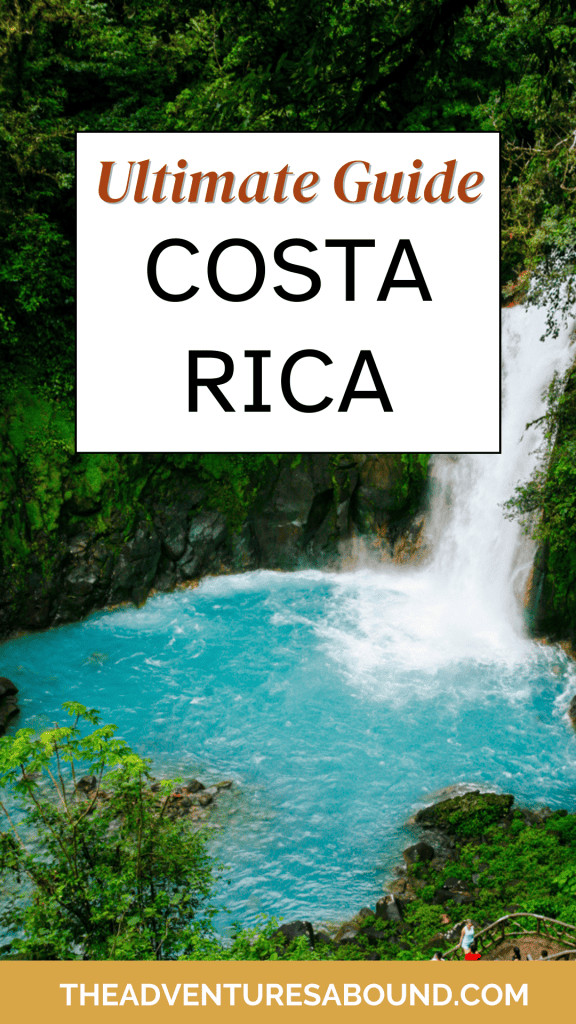 Costa Rica Pin 1
Costa Rica Pin 1